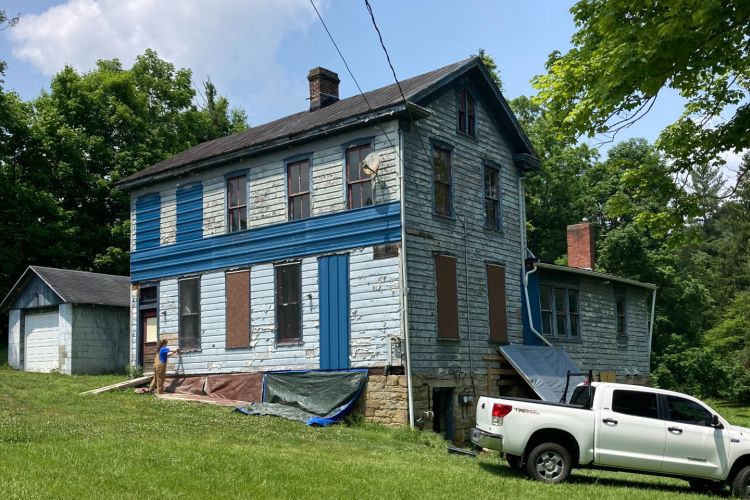
It’s a beautiful house—good bones, as they say. I mean the roof has gone bad, and the walls are bad, and some of the floors are bad, and the foundation is bad. But other than that, it’s a dream!
The first time we walked through the house, I could practically see our realtor shudder. It was uninhabitable. No bank would touch it with a mortgage—what an awful investment! It looks like it might fall over at any moment! It’s not worth saving. The merciful thing to do would be to bulldoze it and put it out of the neighborhood’s misery.
Why did we buy a crumbling house that any reasonable person would turn up their nose at? I could cite the history of the house, the size of the rooms, the acreage. At the heart though, we bought it because we want to save it, and we want to save it because we love it.
Loved “As Is”
There’s something redemptive in saving this old, decrepit house. It was made to be beautiful, and we want to make it beautiful again. In that way, this project reflects the heart of our Father, who “so loved the world, that he gave his only Son, … in order that the world might be saved through him” (from John 3:16–17).
Before we were redeemed by Christ, we had nothing to commend us to God—not even “good bones.” As Paul wrote to Titus, “For we ourselves were once foolish, disobedient, led astray, slaves to various passions and pleasures, passing our days in malice and envy, hated by others and hating one another” (Titus 3:3). We were, by all human measures, not worth saving.
But God did save us! At great personal cost, with sweat and tears and precious blood, Jesus redeemed even me. He didn’t examine me closely and determine that there’s something here he could work with, or do a cost-benefit analysis to see if the work put into me would be worth the outcome. No, God saved me out of his own love and mercy.
Paul continued, “But when the goodness and loving kindness of God our Savior appeared, he saved us, not because of works done by us in righteousness, but according to his own mercy, by the washing of regeneration and renewal of the Holy Spirit” (Titus 3:4-5).
In love Jesus bought us—“as is,” you might say. He wanted you and me, both individually and collectively, to be his treasured possession.
Completed on Schedule
This beautiful, outrageous act of redemption is not the full height of Jesus’s plan for us! He is also, at this moment, currently renewing us.
Jesus places his Holy Spirit in each person who believes. Lovingly, painstakingly, the Spirit is crafting each one of us into pure, spotless saints. We are described as “living stones [that] are being built up as a spiritual house” (1 Peter 1:23), which resonates particularly right now as Zack is repairing the old foundation stone by stone.
The Spirit’s work is not always—in fact, not often—glamorous. I took a mallet to a wall at the house recently. Plaster chunks and wood lath splinters flew, and in an hour or two the wall was reduced to studs and rubble. Our growth as believers can feel that way, shattered and broken. Aren’t we supposed to be growing from one degree of glory to another? Why does it hurt? Why is there so much dust?
Zack and I aren’t naive. We know that this sad, broken house will take years and dollars to bring back to life. It might take more of both than we have. The whole thing could fall down or burn to the ground before we ever get to see it to completion. (Probably not though, right?)
The God who made the world is a more sure builder. “I am sure of this, that he who began a good work in you will bring it to completion at the day of Jesus Christ,” wrote Paul (Philippians 1:6).
Not one of God’s new creations will arrive in heaven behind schedule. The Holy Spirit works patiently, individually, thoughtfully, sometimes one room at a time, sometimes with several projects going at once, sometimes narrowly focused on one particularly malignant problem. But rest assured, at the day of Jesus Christ, you’ll have a fresh coat of paint, a new front porch, and the only strong foundation.
Photo by the author
- The House No One Could Love - July 12, 2023
- Movie Recommendation: The Star (2017) - December 28, 2022
- When Shall We Fold Socks? - November 16, 2022

